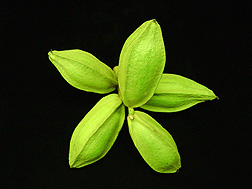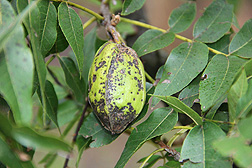New Strategies To Thwart Pecan Scab
|
|
Pecans are great for eating out of the shell or in a myriad of recipes. But abundant pickings of high-quality nuts are only possible if the tree escapes the devastating disease called “pecan scab.” Caused by the fungus Fusicladium effusum, it is the most destructive disease of pecan in the southeastern United States. When scab is severe, most often when rainfall is above average, nut size is reduced, and total crop loss might occur.
Scientists at the Southeastern Fruit and Tree Nut Research Laboratory in Byron, Georgia, are working to help pecan growers mitigate the effect of pecan scab. Research leader Bruce Wood, plant pathologists Clive Bock and Michael Hotchkiss, and entomologist Ted Cottrell are using various approaches to reduce the impact of scab.
Their studies were described in a series of papers in the journals HortScience, Plant Disease, and Crop Protection.
Wood and his colleagues determined that timely foliar applications of nickel to tree canopies can improve tree resistance to the pecan scab pathogen. Nickel is toxic to the scab fungus, providing additional protection.
|
|
“We combined nickel as a nutritional supplement with fungicides and applied them as air-blast sprays to commercial orchards,” says Wood. “On the cultivar Desirable, the reduction in scab severity due to nickel varied from 6 to 52 percent. Fruit weight and kernel filling also increased, apparently from improved disease control.”
Bock and colleagues found that phosphite controlled pecan scab on both foliage and fruit early in the growing season. It also reduced disease on mature fruit, but not as well as an industry standard fungicide, triphenyltin hydroxide. However, scab on fruit late in the season is cosmetic and was previously shown by ARS scientists to have no effect on nut quality or yield.
“In our field tests, phosphite was directly toxic to the pecan scab fungus at concentrations similar to those in the lab,” says Bock. “Phosphite provides an alternative chemistry for growers to consider. This is particularly useful because the scab fungus has developed resistance to some fungicides currently used for control.”
Bock and his colleagues also studied whether fungicides applied from ground-based sprayers are providing adequate scab control in mature pecan trees, which can be 60 to 80 feet tall. They determined that, in pecan trees that did not receive fungicide, the disease was most severe in the lower canopy and least severe at the top of the tree. But in trees that did receive fungicide, disease was reduced only up to a height of 40 feet; above that, there appeared to be no effect of fungicide on disease severity, compared to the nontreated trees.
“There was a consistent reduction in scab severity on foliage and on immature fruit through August due to fungicide treatments below 40 feet,” says Bock. “Where tall pecan trees preclude effective ground-based spray coverage, aerial application might be an option to reduce the severity of scab in the upper canopy. The efficacy of this option is currently being investigated.”—By Sharon Durham, Agricultural Research Service Information Staff.
This research is part of Plant Diseases (#303) and Crop Protection and Quarantine (#304), two ARS national programs described at www.nps.ars.usda.gov.
To reach scientists mentioned in this article, contact Sharon Durham, USDA-ARS Information Staff, 5601 Sunnyside Ave., Beltsville, MD 20705-5128; (301) 504-1611.
"New Strategies To Thwart Pecan Scab" was published in the August 2013 issue of Agricultural Research magazine.








